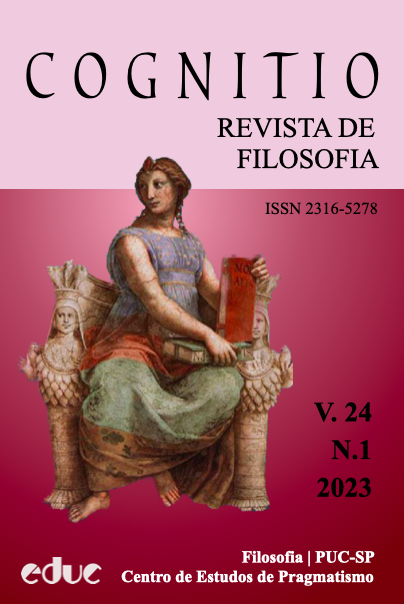Notes toward a Semeiotic of Art
Iconic Beauties in Cosmic Poiesis
DOI:
https://doi.org/10.23925/2316-5278.2023v24i1:e61862Abstract
Although Charles Peirce only rarely applied his semeiotic principles to art, his ideas are highly informative for contemplating the exchange of qualitative meaningin the iconic signs constitutive of art. Reflecting on Peirce’s theory of the icon, three hypo-iconic sub-types, the formative role of the sign-interpretant, and the metaphysical “qualisignificance” of a universe “perfused with signs”, I provide some theoretical notes toward sketching a semeiotic of art. Further illustrative of a Peircean semeiotic of art is the American painting of the Hudson River School and the modern poetry of Wallace Stevens that progressively advance its insights in their own beautiful signs. These philosophers and artists have intellectual roots in Emerson’s transcendentalism with its Neoplatonic legacy, and together form a unique American strand of aesthetics.
References
CARROLL, Joseph. Wallace Stevens’ supreme fiction: a new romanticism. Baton Rouge: Louisiana State University Press, 1987.
CRITCHLEY, Simon. Things merely are: philosophy in the poetry of Wallace Stevens. New York: Routledge, 2005.
DEWEY, John. Art as experience. New York: Minton, Balch & Co, 1934.
DILWORTH, David A. Transcendental naturalism and skeptical materialism: legacy paradigms in Emerson, Santayana, and Peirce. Cognitio: Revista de Filosofia, v. 23, n. 1, p. 1-35, 2022. [https://doi.org/10.23925/ 2316-5278.2022v23i1:e59920].
DILWORTH, David A. Santayana’s anti-romanticism versus Stevens’s new romanticism. Overheard in Se- ville: Bulletin of the Santayana Society, v. 35, p. 32-48, 2017. [https://doi.org/10.5840/santayana201735358].
DILWORTH, David A. The life of the spirit in Santayana, Stevens, and Williams. Overheard in Seville: Bul- letin of the Santayana Society, v. 23, p. 16-22, 2005. [https://doi.org/10.5840/200523234].
DURAND, Asher. Letter I, Letter IV, and Letter VII, Letters on landscape painting. The crayon, v. 1, n. 1; 7; 18, p. 1-2; 97-98; 273-275, 1855. [https://doi.org/10.2307/25526853].
EMERSON, Ralph Waldo. Beauty. In: EMERSON, Ralph Waldo. The conduct of life, v. 6, The Collected Works of Ralph Waldo Emerson. Cambridge: Harvard University Press, 2003, p. 149-163.
GUARDIANO, Nicholas L. Aesthetic transcendentalism in Emerson, Peirce, and nineteenth-century Ameri- can landscape painting. Lanham: Lexington Books, 2017a.
GUARDIANO, Nicholas L. Charles S. Peirce’s New England neighbors and embrace of transcendentalism. Transactions of the Charles S. Peirce Society, v. 53, n. 2, p. 216-245, 2017b. [https://doi.org/10.2979/tran- charpeirsoc.53.2.03].
GUARDIANO, Nicholas L. Metaphysical grounds of universal semiosis. Cognitio: Revista de Filosofia, v. 21, n. 2, p. 231-243, 2020. [https://doi.org/10.23925/2316-5278.2020v21i2p231-245].
GUARDIANO, Nicholas L. Transcendentalist encounters with a universe of signs. The American Journal of Semiotics, v. 37, n. 1-2, p. 5-45, 2021. [https://doi.org/10.5840/ajs202172772].
HEADE, Martin Johnson. Papers. Archives of American Art, Washington, D.C. 2007. https://www.aaa.si.edu/ collections/martin-johnson-heade-papers-7699
HOCUTT, Max Oliver. The logical foundations of Peirce’s aesthetics. Journal of Aesthetics and Art Criti- cism, v. 21, p. 157-166, 1962. [https://doi.org/10.1111/1540_6245.jaac21.2.0157].
INNIS, Robert. Dewey’s Peircean aesthetics. Cuadernos de Sistemática Peirceana, v. 6, p. 139-160, 2014.
JAPPY, Tony. Introduction. In: JAPPY, T. (Ed.). The Bloomsbury companion to contemporary
Peircean semiotics. London: Bloomsbury Academic, 2020. p. 1-29.
KANT, Immanuel. Critique of judgment. Trans. Werner S. Pluhar. Indianapolis: Hackett Publishing, 1987.
LEFEBVRE, Martin. Peirce’s esthetics: a taste for signs in art. Transactions of the Charles Peirce Society, v. 43, n. 2, p. 319-344, 2007. [https://doi.org/10.2979/TRA.2007.43.2.319].
LEVI, Albert William. Peirce and painting. Philosophy and Phenomenological Research, v. 23, n. 1, p. 23-36, 1962. [https://doi.org/10.2307/2104986].
MORRIS, Charles W. Esthetics and the theory of signs. Journal of Unified Science (Erkenntniss), v. 8, n. 1/3, p. 131-150, 1939. [https://doi.org/10.1007/BF00176021].
PEIRCE, Charles S. The essential Peirce: selected philosophical writings. HOUSER, Nathan; KLOESEL, Christian; Peirce Edition Project (Eds.). Bloomington: Indiana University Press, 1992; 1998. 2 vols. [Cited as EP followed by volume and page number].
PEIRCE, Charles S. Selected writings on semiotics, 1894–1912. BELLUCCI, Francesco (Ed.). Mouton: De Gruyter, 2020. [Cited as SWS followed by page number].
PEIRCE, Charles S. Prolegomena to an apology for pragmaticism. The Monist, v. 16, n. 4, p. 492-546, 1906. [https://doi.org/10.5840/monist190616436].
POLLOCK, Jackson. My painting. In: KARMEL, Pepe (Ed.). Jackson Pollock: interviews, articles, and re- views. New York: The Museum of Modern Art, 1999. p. 17-18.
POLLOCK, Jackson. Interview by William Wright, WERI, Rhode Island, 1950. In: KARMEL, Pepe (Ed.). Jackson Pollock: interviews, articles, and reviews. New York: The Museum of Modern Art, 1999. p. 20-23.
SANTAYANA, George. The sense of beauty: being the outline of aesthetic theory. New York:
Dover, 1955.
SHORT, T. L. Peirce’s theory of signs. Cambridge: Cambridge University Press, 2007.
SMITH, C. M. The aesthetics of Charles S. Peirce. Journal of Aesthetics and Art Criticism, v. 31, n. 1, p. 21- 29, 1972. [https://doi.org/10.2307/429607].
STEBBINS, Jr., Theodore E. The life and work of Martin Johnson Heade: a critical analysis and
catalogue raisonné. New Haven: Yale University Press, 2000.
STEVENS, Wallace. The collected poems of Wallace Stevens. New York: Vintage Books, 1990.
STEVENS, Wallace. Adagia. In: BATES, Milton J. (Ed.). Opus Posthumous. New York: Vintage Books, 1989. p. 184-202.
STEVENS, Wallace. Letters of Wallace Stevens. STEVENS, Holly (Ed.). Berkeley: University of California Press, 1966.
STEVENS, Wallace. Effects of Analogy. In: STEVENS, Wallace. The necessary angel: essays on reality and the imagination. New York: Vintage Books, 1951 (1948). p. 105-130.
TWAIN, Mark. Quoted in: NOVAK, Barbara. Voyages of the Self: Pairs, Parallels, and Patterns In American Art and Literature. New York: Oxford University Press, 2007. p. 62-63.
Downloads
Published
How to Cite
Issue
Section
License
Copyright (c) 2023 http://creativecommons.org/licenses/by/4.0/

This work is licensed under a Creative Commons Attribution 4.0 International License.









